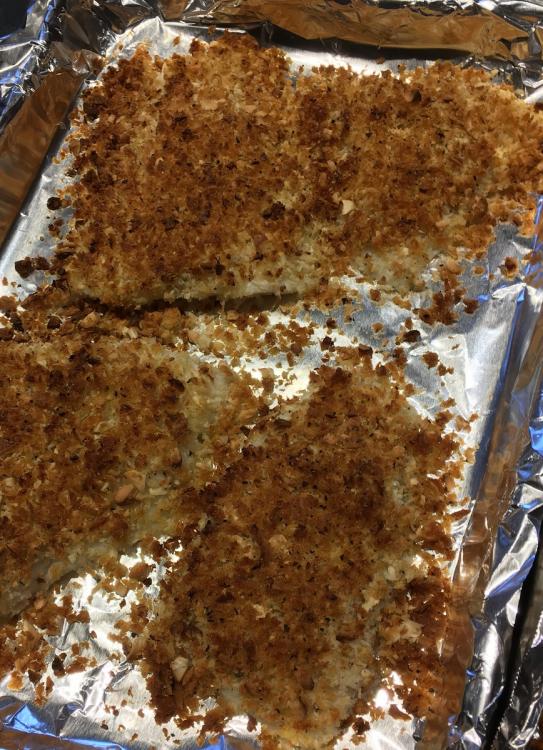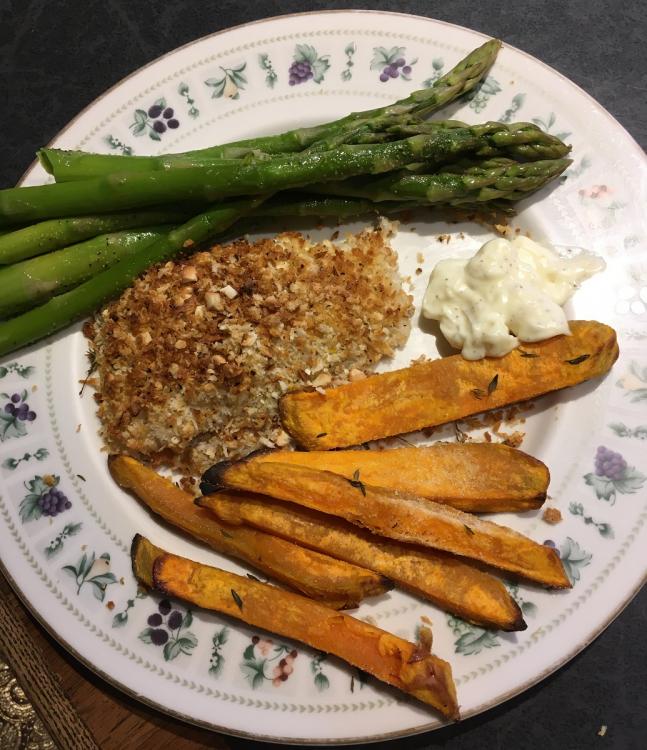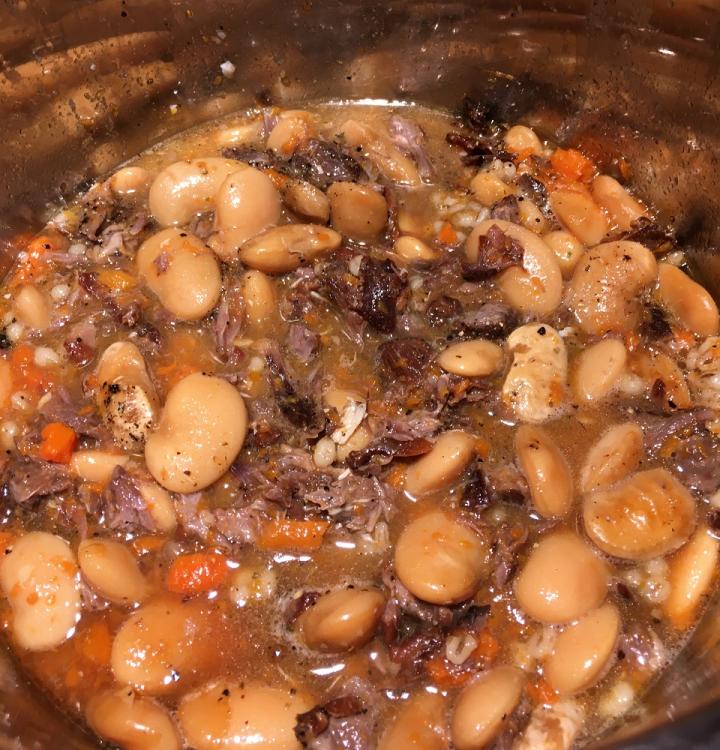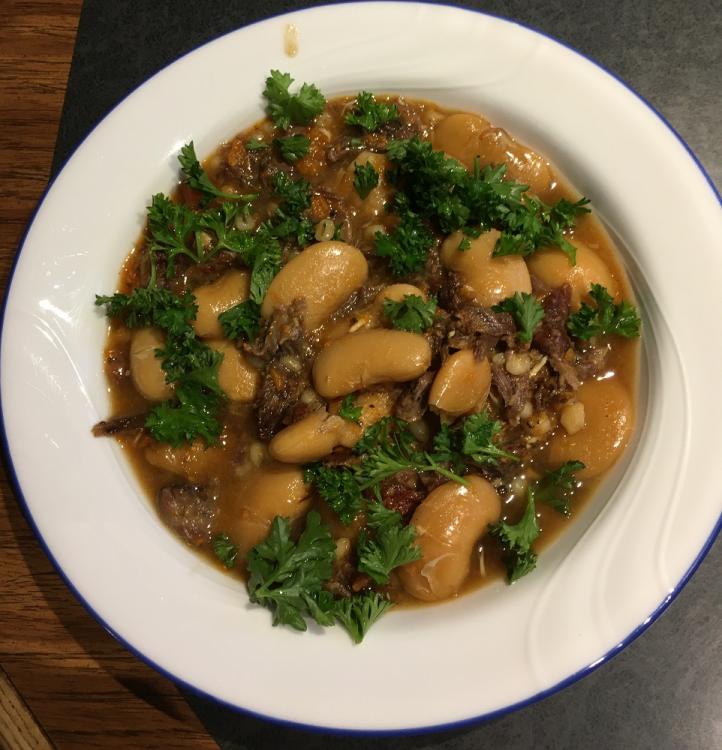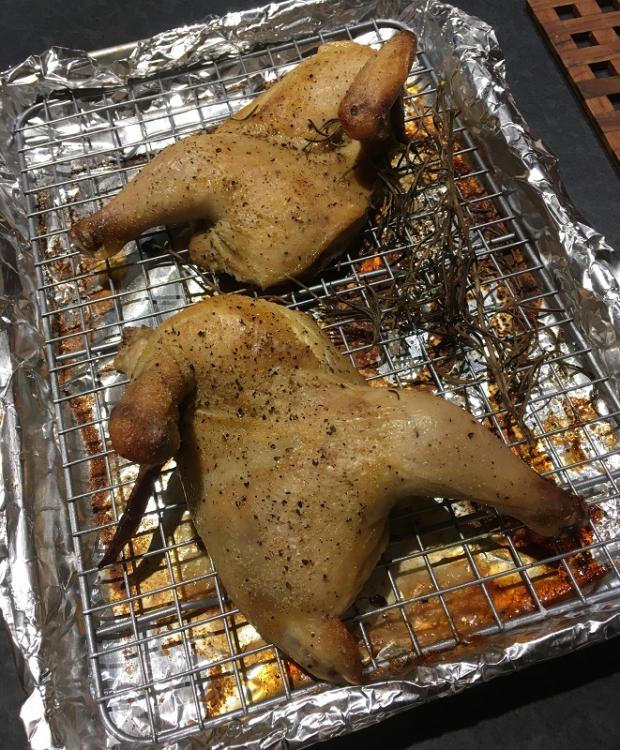-
Posts
3,040 -
Joined
-
Last visited
Content Type
Profiles
Forums
Store
Help Articles
Everything posted by TdeV
-
Hello Yum Yum, your food looks scrumptious! You will find many friends here. Welcome to eG.
-
Today I tried to duplicate yesterday's wonder with sweet potato and homemade mayonnaise, only this time with russet potatoes. Yesterday's mayonnaise with a sprinkle of already ground black mustard seed. Not even close to the magic of yesterday.
-
Thanks @JoNorvelleWalker and @jimbo. Do you have a recommended site to buy these pans?
-
Agreed @palo. Any idea where to find a good Anova oven sized pan?
-
Yesterday we had baked fish with sweet potatoes, fresh mayonnaise, and asparagus. I worked with this recipe from steamandbake. The sweet potatoes were cut and soaked in salty water so they wouldn't brown, dried off, tossed in couple tablespoons oil (in a plastic bag), laid out on the Anova sheet pan, dusted with some semolina, garlic cloves and thyme. The Anova pan is quite thin and buckled mid-cook. Anyone have a good replacement? This was my second try at homemade mayonnaise, but the first time with the Bamix using the small container (which might be too small). Ingredients: jumbo egg, freshly ground black mustard seed, <tsp salt, white wine vinegar, canola. Tasted salty to me when just made. But, I have to tell you, HOT sweet potato fries dipped in fresh mayonnaise is absolutely divine! 😋 😋 The fish was lemon flounder fillet, dried and placed on a 1/4 sheet USA pan which did not buckle. Dressing (none leftover) was 100g panko, 30 g chopped raw cashew, zest from one Meyer lemon, freshly ground pepper, enough olive oil to make the crumbs stick together. Served with the Meyer lemon and asparagus. With a little practise this would be a very fast meal. And tasty.
-
@dtremit, thanks. Those Royal Corona beans are truly amazing. I only used 1/2 pound because I was afraid that the dish would be huge. The beans were soaked overnight in gelatinous lamb stock. I wanted to make a bean dish which wasn't a soup (my default method), so the beans were covered in only a small amount (a knuckle's worth) of stock. Thinking it was best to check if the liquid was adequate, the beans were cooked for 7 minutes High Pressure with a 20 minute rest. (My IP RG cheat sheet says Corona beans soaked should be cooked for 10-12 minutes) At 7 minutes, they weren't done, but they weren't rock hard either. Adding additional time + rest is a crap shoot for me, so I skipped it. I had other things to cook in the broth anyway. The IP simmered at Slow Cooker Medium for a couple of hours. Probably the pot was turned up to Slow Cooker Custom (201°F) for 30 minutes to get stuff really hot. If I had to guess, I would do soaked Royal Corona for 8 or 9 minutes.
-
I made mayonnaise this afternoon; it's better than the last time I tried to make it, but still a bit wonky. I told DH he had to use it up! 🤣 But, I decided late that I wanted to make mayonnaise, and so I fussed all afternoon because the egg was cold for a very long time. So, in future, can I take an egg out of the fridge and leave it on the counter for 24 hours?
-
Well, greetings @jetfin. I'm very interested in your explorations. The folks here on eG are a friendly crowd. Welcome!
-
Meaty lamb bones roasted at 425°F to brown slightly. Bones went into Instant Pot with onion, carrot, celery for 1.5 hrs at high pressure (HP) for higly gelatinous lamb stock. Meat cleaned and saved. 1/2 lb Rancho Gordo Royal Corona beans then cooked HP in lamb stock. Separately high pressure steamed 1/4 cup pearled barley. Added a couple of carrots, and IP set to Slow Cook Medium. Dressed with fresh parsley and a drizzle of Lemon Balsamic.
-
@JoNorvelleWalker, yes. Should the bird have been on a higher shelf?
-
Please explain, @mgaretz.
-
Hi Holly. Do your sons like "usual" pizza toppings or radical ones? Lots of great folk on these forums, so you'll surely have a great time! Welcome to eGullet.
-
@JoNorvelleWalker's recipe. Begun by liberally sprinkling salt, pepper + garlic onto the hen, then into the fridge, for about 7 hours. APO set manually, with probe set to 162°F. Still, I got a message on my phone that the APO oven had come to temperature. Then I got a message that the probe had reached 0°F, which I thought was odd, but assumed that meant that the APO was just starting to pay attention to the thermometer. Actually, I now think that was the APO saying it was done. So, too well done (about 180°F). Quite tasty. Could the lack of browning be due to the surface of the meat being very dry?
-
My neighbour has just gifted me some Cornish game hens (with a lemon, fresh rosemary and garlic). I'm interested in doing these in the steam oven. Can you help @Kim Shook @Shelby @JoNorvelleWalker @Okanagancook @gfweb ????
-

Hello from a little town in Connecticut with no restaurant, for now.
TdeV replied to a topic in Welcome Our New Members!
Hello @Graycenphil. In many phases of my life I have enjoyed eating out at small, interesting restaurants. I wish you good luck in finding a chef and restaurateur, there are many highly knowledgeable folk here. Welcome to eGullet. -
Duvel, can you provide a recipe for this scrumptious looking dish?
-
Opinion: - Cooking process needs refinement. Results: - Corned beef was okay - Cooking vegetables (carrots) seemed raw after 24 hour cook. Convection oven dried out the surface, cooked more and browned the veg. Tasted fabulous! (Of course the veg was covered in fat) - Eaten with boiled potatoes - Cooking water reduced, honey and cornstarch added. Very tasty. So, okay. Sorry no photos.
-
Update from yesterday's sous vide. I didn't use the automatic recipe because I'm learning to understand this machine. The recipe calls for inserting the probe into the corned beef (which I thought was wierd) and I set the probe temperature to 155°F 100% steam. Naturally the oven turned itself off last night (fortunately, before I went to bed). Reset the temp to 155°F without the probe, so the total time is about 24 hours. Just removed from the oven because I'm trying to get ready for an outdoor wine/dinner party. There is over 1/4" water (1 cup) at the bottom of the oven. Do you have any special tricks for getting rid of this? (Or, I will wait until it cools down and remove with sponge). Notes: - Definitely more chewy than after 60 hours. Was expecting meat to have more flavour. - The vegetables aren't raw, but they almost look like it. Am broiling in 450°F oven with top and rear elements on. Sous vide is wrapped in tin foil. Ordinary oven won't go that low. Where to keep it? - Cooking juices not reduced. Reducing now on stovetop.
-
Sorry, @heidih, it was either laugh or cry!
-
Using the old method (joule), I am just finishing a sous vide of duck legs at 160°F for 28 hours. I was going to finish in the Anova oven but it's busy with dinner for tomorrow. Am I now like @JoNorvelleWalker and and I need TWO Anova ovens? 🤣 🤣 I have just started a cowboy version of an Anova recipe for sous vide corned beef which is 24 hours at 155°F in the Anova oven. This meat is not bagged. I removed a lot of the fat cap before starting. There is 1/4 cup cider vinegar, 1/4 cup boiled apple cider (from King Arthur), a splash of maple syrup, 2 medium onions, 2 carrots, 1 apple, some butcher-supplied spice packet, about a cup of water, and the corned beef. I want to see what this tastes like tomorrow. (My notes for corned beef have 135°F for 60 hours with Joule.)
-
Hmmm. I still haven't quite figured out that "braise thing" here. I'll be collecting a leg of lamb this afternoon from the butcher, so perhaps I will try this . . . 🙄
-
So how long do you cook each, @Duvel?
-
Curious. I've always thought lamb leg/shoulder equivalent. Wrong, am I? 😜



